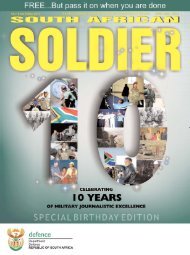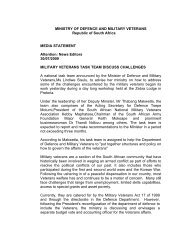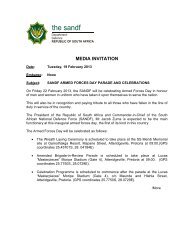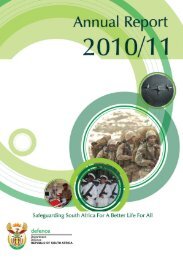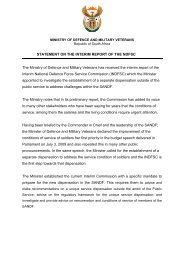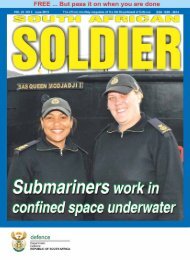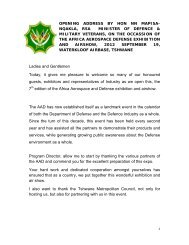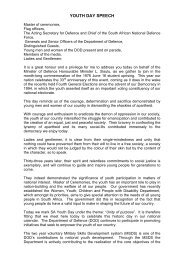FY2006/07 to FY2008/09 - Department of Defence
FY2006/07 to FY2008/09 - Department of Defence
FY2006/07 to FY2008/09 - Department of Defence
Create successful ePaper yourself
Turn your PDF publications into a flip-book with our unique Google optimized e-Paper software.
chapter 2human, is detailed in the following resource strategies: Human Resources Strategy 2010. <strong>Defence</strong> Information Management Strategy. Joint Logistic Strategy. Capital Renewal Strategy.The resources strategies provides the ends, ways andmeans <strong>to</strong> be effective and efficient in its role <strong>of</strong> attainingthe <strong>Defence</strong> Strategic Objectives, as indicated and representedin Figure 2.3, DOD <strong>Defence</strong> Strategy forms the caps<strong>to</strong>ne <strong>of</strong>all the strategies and plans, and articulates thecorporate strategic objectives (ends), a missionbasedapproach <strong>to</strong> strategic military conceptsas the ways by which <strong>to</strong> achieve these objectivesand the capabilities as the means <strong>to</strong>achieve the strategic objectives. Resource strategies that prescribe the evolution<strong>of</strong> key resources, ie human resources, materielresources, financial resources and the informationresources, as fundamental means <strong>to</strong> enablethe DOD <strong>Defence</strong> Strategy. Core capability system strategies that prescribethe evolution <strong>of</strong> resource configurations andmethods in support <strong>of</strong> the DOD <strong>Defence</strong>Strategy and Resource Strategies. Resource system plans that translate the strategiesin<strong>to</strong> realistic and executable plans.R e s e r v e F o r c e S t r a t e g yThe Reserve Force Strategy is an essential supportingstrategy <strong>to</strong> the Military Strategy as it enables the SANDF<strong>to</strong> provide affordable defence capabilities for theRepublic <strong>of</strong> South Africa. The availability <strong>of</strong> specialistskills and the expansion capacity inherent in theReserves ensure sustainability <strong>of</strong> military operations.The Reserve Force contributes <strong>to</strong> all three MilitaryStrategic Objectives as it is considered <strong>to</strong> be an integratedpart <strong>of</strong> the <strong>to</strong>tal or "one force" which executes the militarymissions. It also adds value <strong>to</strong> the MilitaryStrategic Concepts by enhancing specialist skills, providingthe expansion capability and is structured interms <strong>of</strong> a ready, first line and second line Reserve.When coupled <strong>to</strong> the implementation <strong>of</strong> HR Strategy2010 it is regarded as the primary <strong>to</strong>ol in achievingaffordable and sustainable defence capabilities.H u m a n R e s o u r c e s S t r a t e g y 2 0 1 0The aim <strong>of</strong> the DOD HR Strategy 2010 is <strong>to</strong> ensure theavailability <strong>of</strong> the right number and quality <strong>of</strong> humanresources in the right place at the right times, which areeffectively, efficiently and economically managed andadministered.The strategic goals <strong>of</strong> the HR Strategy 2010 are as follows: To rejuvenate the SANDF's (HR) compositionwith young, fit and healthy members who meetthe requirements for operational utilisation. To achieve an affordable HR composition. To adequately resource and utilise the RegularForce and the Reserve Force. To replace the current SANDF service systemwith a new service system that will reduce personnelexpenditure and optimise force levelflexibility. To attain a broad level <strong>of</strong> representivity at alllevels and in all occupational classes. To improve HR service delivery. To obtain equity in the management andadministration <strong>of</strong> uniformed and civilian personnel. To retain the required operational and functionalexpertise.D e f e n c e I n f o r m a t i o n M a n a g e m e n t S t r a t e g yThe focus <strong>of</strong> the <strong>Defence</strong> Enterprise Information Systems(DEIS) is "To ensure that the DOD information infrastructureprovides appropriate command and managementand is fully integrated and aligned with theCabinet's "Executive Information Management System."Statement by Minister <strong>of</strong> <strong>Defence</strong>. To this end, theInformation Strategy ensures that the required futureInformation Resource <strong>of</strong> the DOD is available <strong>to</strong> the rightpeople, at the right time, in an efficient, reliable, andsecure manner by means <strong>of</strong> a superior EnterpriseInformation System (EIS). The EIS must be able <strong>to</strong> communicateacross static and deployable operating arenasand across business and military boundaries with dueinformation security measures, and by using any appropriatecommunication medium. It must heed financialconstraints and demonstrate the highest collective value<strong>to</strong> the DOD at large; therefore the DOD must embracerationalisation efforts in which duplication is eradicatedand re-usability and sharing <strong>of</strong> EIS elements are promoted<strong>to</strong> the maximum extent.The DEIS Context and Construct <strong>to</strong> Ensure StrategicAlignment with DOD Business are based on the following: The ability <strong>to</strong> ensure appropriate Commandand Control. The ability <strong>to</strong> appropriately execute <strong>Defence</strong>Administration. The ability <strong>to</strong> effectively support Commandand Control and <strong>Defence</strong> Administration bymeans <strong>of</strong> a Common Information System. The ability <strong>to</strong> effectively support Commandand Control and <strong>Defence</strong> Administration byS T R A T E G I C B U S I N E S S P L A N F Y 2 0 0 6 / 0 7 T O 2 0 0 8 / 0 913



